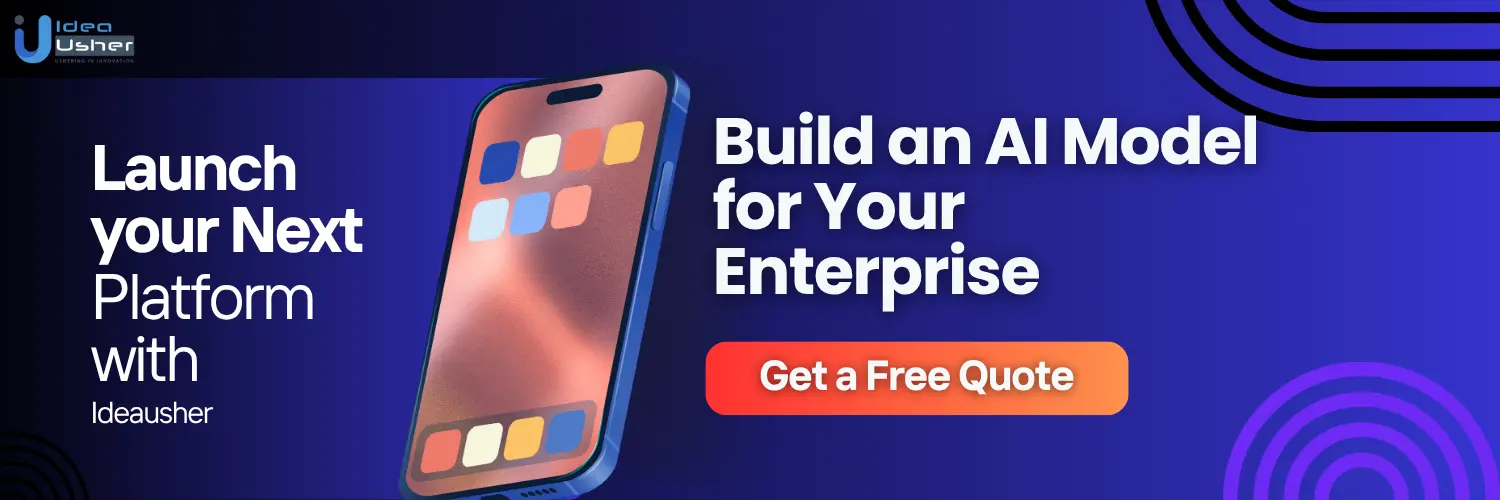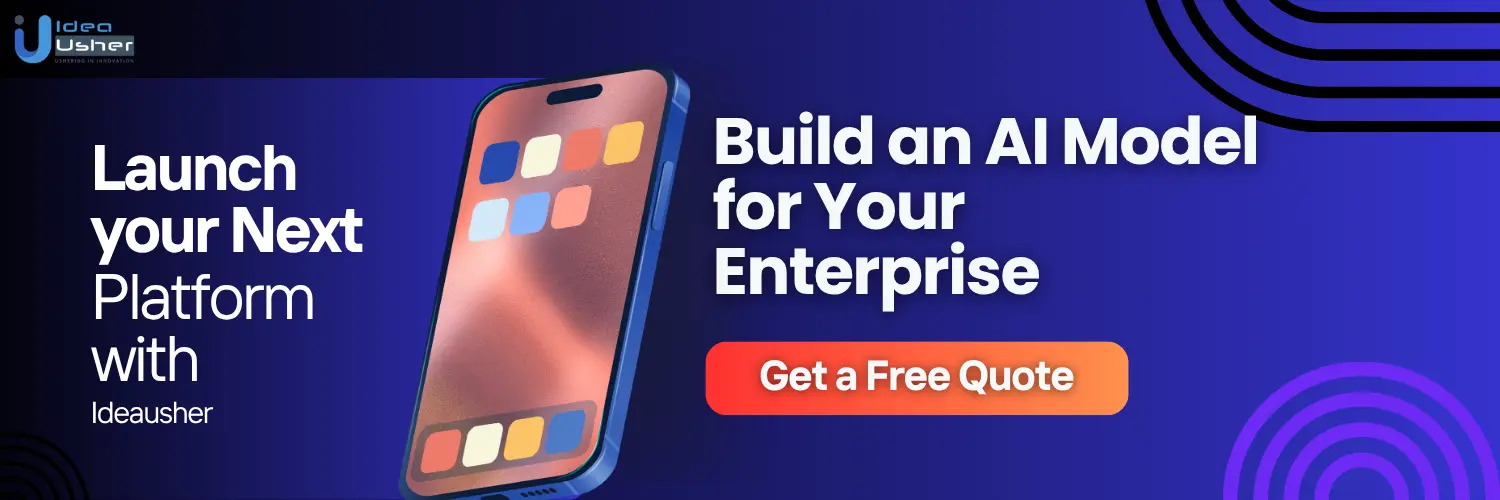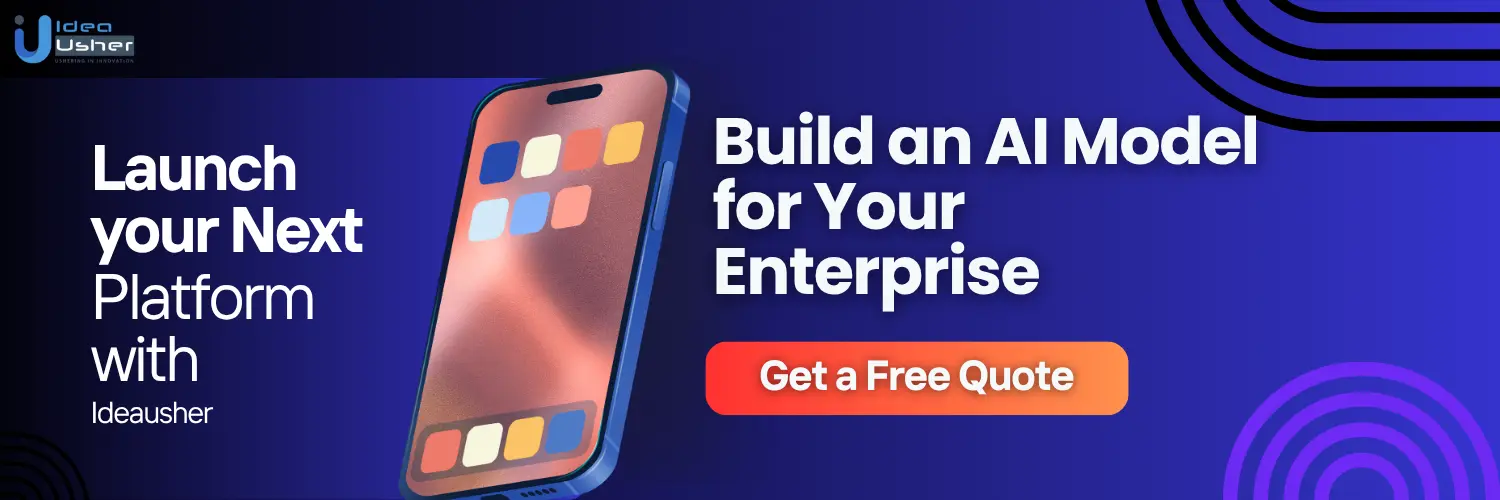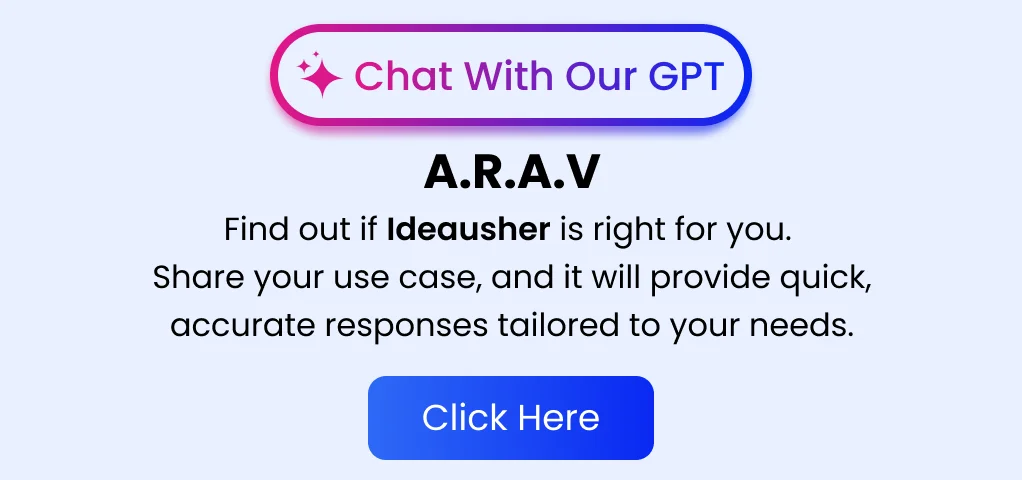As we move through 2025, AI is quickly becoming a must-have tool for businesses, but not in the simple, off-the-shelf way you might expect. For enterprises, it’s all about customizing AI models to fit their specific needs, integrating smoothly with existing systems, and scaling as the business grows. It’s not just about handling huge amounts of data; security, transparency, and explainability are key factors that make this process more complex.
While building AI for general use might be easier, creating AI solutions for enterprise platforms is a whole different ball game. But getting it right is essential if businesses want to stay competitive in today’s fast-paced world.
We’ve helped numerous organizations design AI models that not only solve specific business challenges but also scale to meet future needs by incorporating tools like NLP and predictive analytics for customer insights, supply chain optimization, and risk management. IdeaUsher has experience in addressing the evolving needs of enterprise-scale AI, and we’re here to guide you through the process. We’re using this blog as a way to provide helpful insights, helping you build an enterprise-level AI model that delivers long-term value.
Key Market Takeaways for an AI Model for Enterprises
According to GrandViewResearch, the enterprise AI market is on a rapid growth trajectory, projected to increase from $23.95 billion in 2024 to $155 billion by 2030. This growth, fueled by a CAGR of 37.6%, highlights how businesses are increasingly adopting AI to enhance efficiency, streamline operations, and stay competitive in a fast-paced digital world. Companies are leveraging AI’s power to automate processes, analyze data, and make smarter decisions, all of which are critical for innovation and survival in today’s market.
Source: GrandViewResearch
AI adoption is gaining momentum across industries as organizations recognize its potential to solve complex problems and drive business growth. In sectors like healthcare, finance, retail, and manufacturing, AI models are being integrated to automate tasks, improve customer service, and optimize processes.
The growth of cloud infrastructure and accessible data has made it easier for businesses of all sizes to implement AI, democratizing its benefits and making it scalable for enterprises across the board.
Leading companies are already using AI to innovate and set new standards in their industries. For example, VideaHealth is using AI to improve the accuracy of dental diagnostics, while BMW leverages AI to optimize its supply chain management. John Deere is enhancing agricultural productivity with computer vision, and DHL is streamlining logistics by applying AI for better route planning and warehouse management.

What is an Enterprise AI Model?
At its core, an enterprise AI model is a sophisticated machine learning (ML) or deep learning system that processes vast amounts of data to provide actionable insights and predictions. These models are not just theoretical constructs but are used in real-world applications across industries like retail, manufacturing, healthcare, and finance.
An enterprise AI model serves various functions, including:
- Process both structured and unstructured business data—this could range from databases and spreadsheets to more complex forms of data like images, videos, or social media content.
- Automate or augment decision-making in critical business areas such as customer service, fraud detection, supply chain management, and predictive maintenance.
- Integrate seamlessly with existing IT infrastructure, for example, it might work with enterprise resource planning systems, customer relationship management tools, or cloud platforms.
How AI Functions in Enterprise Environments?
AI in the enterprise context follows a structured and systematic approach to deliver value. The journey of an enterprise AI model typically involves several stages:
| Stage | Sub-Stage | Description |
| Data Pipelines | Ingestion | Collecting data from various sources such as IoT devices, transaction records, logs, or customer interactions. |
| Preprocessing | Cleaning, normalizing, and labeling data to ensure it’s suitable for AI model training. | |
| Feature Engineering | Identifying key data points (features) that will significantly influence the model’s predictions. | |
| Model Training & Deployment | Training | Training AI models using historical data to recognize patterns, relationships, and trends. |
| Validation | Validating the model’s accuracy and performance to ensure it works as expected. | |
| Deployment | Deploying the model through APIs or embedding it into existing business applications for real-time use. | |
| Decision Automation & Augmentation | Automation | Automating repetitive tasks like invoice processing or handling customer queries. |
| Real-time Insights | Providing real-time insights, such as fraud alerts or demand predictions, to enhance decision-making. | |
| Integration with Legacy Systems, Cloud, and APIs | Hybrid Cloud | Using both on-premises and cloud-based solutions to ensure scalability and flexibility in AI deployment. |
| APIs | Connecting AI models to legacy systems and third-party software, ensuring seamless integration and operation. |
Why Enterprises Are Embracing AI Models?
AI is quickly becoming a must-have for businesses, helping them streamline operations, boost efficiency, and improve customer service. It’s making routine tasks easier, uncovering valuable insights from data, and allowing companies to stay competitive by driving innovation. Simply put, AI is helping businesses work smarter, not harder.
- Automation of Repetitive Tasks and Decision-Making: AI automates manual tasks like data entry and decision-making, reducing human error and allowing employees to focus on more strategic work. For example, a bank cut mortgage processing from 45 days to 72 hours with AI.
- Unlocking Business Insights from Massive Datasets: AI helps businesses analyze large datasets to uncover patterns, predict trends, and make real-time decisions. A retail chain used AI to improve inventory, boosting profitability by $18M annually.
- Enhancing Customer Experiences: AI-driven chatbots, personalized recommendations, and sentiment analysis improve customer service and satisfaction. An e-commerce platform saw a 40% rise in customer satisfaction after using AI personalization.
- Optimizing Logistics, Forecasting, and Resource Planning: AI optimizes logistics, workforce planning, and pricing, reducing costs and improving efficiency. A manufacturer achieved 99.2% on-time delivery using AI-powered supply chain management.
- Gaining Competitive Edge Through Innovation: AI drives innovation, creating new products and revenue streams while helping businesses stay ahead of competitors. AI users respond to market changes 3-5x faster than non-AI companies.
Types of AI Models Used in Enterprises
Enterprise AI encompasses a range of models, from basic machine learning to advanced deep learning systems, each tailored for different business needs.
1. Machine Learning Models
Machine learning is one of the most widely used types of AI in businesses. These models learn from data, improving their performance over time.
Supervised Learning
These models are trained on labeled data (input-output pairs), enabling businesses to predict or classify outcomes. Common use cases include:
- Customer Churn Prediction: Predicting which customers are likely to leave using models like Logistic Regression.
- Sales Forecasting: Using Linear Regression to predict future sales trends based on historical data.
- Spam Detection: Identifying spam emails through algorithms like Naïve Bayes.
Unsupervised Learning
These models identify hidden patterns within unlabeled data, making them useful for discovering insights without predefined categories. Enterprise applications include:
- Customer Segmentation: Using K-Means Clustering to group customers based on behavior and preferences.
- Anomaly Detection: Identifying unusual transactions or fraud using Autoencoders.
- Market Basket Analysis: Finding associations between products purchased together using the Apriori algorithm.
Reinforcement Learning
This model learns by interacting with an environment and receiving feedback. It’s especially effective for tasks that involve optimization and strategy, such as:
- Dynamic Pricing: Adjusting e-commerce prices in real-time based on demand and supply.
- Supply Chain Optimization: Automating inventory management through autonomous systems.
- Robotic Process Automation (RPA): Using AI for automating repetitive business processes like invoice approvals and data entry.
2. Deep Learning Models
Deep learning, which involves neural networks, is particularly useful for processing complex, high-dimensional data. These models are excellent at extracting intricate patterns from large datasets.
Neural Networks for Enterprise AI
- Convolutional Neural Networks (CNNs): Ideal for image recognition, such as detecting defects in manufacturing or automating quality control.
- Recurrent Neural Networks (RNNs): Perfect for time-series forecasting, such as predicting stock market trends or demand fluctuations in supply chains.
- Transformers & Large Language Models (LLMs): These models are used for natural language processing tasks like chatbots, document summarization, and automated customer support.
Large-Scale Data Modeling
Deep learning is especially suited for processing vast amounts of data, like sensor data in predictive maintenance. It’s used in industries such as manufacturing to predict equipment failures before they happen, reducing downtime and maintenance costs.
Pattern Recognition in Complex Datasets
AI models excel in identifying trends in unstructured data, such as customer feedback, social media content, and even call transcripts. This can be used for applications like Sentiment Analysis, helping businesses understand customer perceptions and improve services.
Popular AI Models & Their Business Applications
AI models can help businesses with tasks like predicting sales, detecting fraud, or automating customer support. Some excel at analyzing text or images, while others are better for predicting trends or behaviors. The right model depends on your business needs, whether it’s quick results or deeper insights from complex data.
1. Linear Regression & Logistic Regression
Linear and Logistic Regression are fundamental statistical models used for predicting outcomes. Linear regression predicts continuous values, while logistic regression is used for binary classification. These models are simple, easy to implement, and interpretable, making them a great choice for many business problems.
Enterprise Use Cases:
- Sales Forecasting: Predict future sales based on historical market data.
- Customer Churn Prediction: Identify at-risk customers to implement retention strategies.
- Credit Risk Assessment: Evaluate the likelihood of loan default to make informed lending decisions.
Best For: Linear and Logistic Regression models work best with structured, numerical data. They are fast and easy to interpret, making them ideal for clear, actionable insights in decision-making.
2. Decision Trees & Random Forests
Decision Trees are hierarchical models that split data based on rules. Random Forests are an ensemble of decision trees that improve accuracy and reduce overfitting. These models are highly intuitive and can handle both classification and regression tasks efficiently.
Enterprise Use Cases:
- Fraud Detection: Detect suspicious activities or transactions.
- Credit Scoring: Automate loan approval decisions.
- HR Recruitment: Screen resumes based on specific criteria.
Best For: Decision Trees and Random Forests are perfect for high-dimensional datasets with complex relationships. They also offer clear interpretability, making them ideal when understanding the decision-making process is important.
3. Large Language Models
LLMs, such as GPT-4, are advanced AI models capable of understanding, generating, and processing human language, making them ideal for text-heavy tasks. These models are particularly useful for automating customer service, document generation, and even creative writing.
Enterprise Use Cases:
- AI-Powered Customer Support: Handle 24/7 customer service inquiries autonomously.
- Legal & Compliance: Extract clauses from contracts for legal and compliance analysis.
- Technical Documentation: Auto-generate API documentation and user manuals.
Best For: Large Language Models are ideal for text-heavy workflows like customer service, legal work, and content creation. They excel in handling vast knowledge bases, enabling intelligent text processing for more efficient operations.
4. Convolutional Neural Networks
CNNs are specialized neural networks designed to process and recognize patterns in visual data, such as images and videos, by mimicking the way human vision works. They are particularly effective for applications in image and video recognition, medical imaging, and other visual tasks.
Enterprise Use Cases:
- Defect Detection: Identify flaws in products using real-time image analysis.
- Medical Imaging: Diagnose diseases through X-rays, MRIs, or CT scans.
- Automated Invoice Processing: Extract data from scanned receipts and invoices.
Best For: Convolutional Neural Networks are perfect for high-accuracy image classification and computer vision tasks. They are also ideal for real-time decision-making based on visual data, such as defect detection or medical imaging.
5. Recurrent Neural Networks
RNNs are a type of neural network designed for processing sequential data, making them ideal for tasks involving time-series or text data. They excel at capturing temporal dependencies, making them useful for forecasting and real-time predictions.
Enterprise Use Cases:
- Predictive Maintenance: Monitor equipment data to predict failures before they happen.
- Financial Market Analysis: Forecast stock prices and market trends.
- Voice Assistants: Transcribe and process voice data for customer service.
Best For: Recurrent Neural Networks are ideal for temporal (time-based) data and real-time sequence prediction. They excel in tasks involving sequential patterns, such as analyzing customer interactions or predicting equipment failures.

How to Build an AI Model for Enterprises?
We guide enterprises through the step-by-step process of building tailored AI models that address their unique business challenges. Our goal is to help businesses enhance operational efficiency, make data-driven decisions, and scale effectively. Here’s how we build an AI model for your enterprise from start to finish:
1. Define Business Problem & ROI Goals
We begin by clearly identifying the business problem you want to solve—whether it’s automating a process, making predictions, or optimizing operations. Then, we work with you to establish measurable success metrics and ROI goals, ensuring alignment with your broader business objectives.
2. Collect & Prepare Enterprise-Grade Data
Next, we gather relevant internal data from various sources and integrate third-party data where necessary. We also ensure strict compliance with data regulations such as HIPAA or GDPR. Our team takes care of data preprocessing, including cleaning, labeling, and feature engineering, to ensure your data is in the best shape for training the model.
3. Choose Model & Learning Paradigm
We then help you choose the most suitable model based on the complexity of the problem, the volume of data, and the need for explainability. We discuss the pros and cons of open-source versus proprietary models to find the best fit for your business needs and technical capabilities.
4. Train & Validate the Model
With the model selected, we split your data into training and validation sets, using techniques like cross-validation and hyperparameter tuning to ensure optimal performance. Our MLOps tools help ensure the entire process is reproducible and efficient, streamlining the model training process.
5. Deploy the Model to Production
Once your model is trained and validated, we deploy it seamlessly using APIs and microservices architecture, ensuring easy integration into your existing infrastructure. Whether it’s on-premises, hybrid, or cloud-based (e.g., AWS SageMaker, Azure ML), we tailor the deployment strategy to your specific needs.
6. Monitor, Update & Scale the Model
After deployment, we set up real-time performance dashboards to monitor the model’s effectiveness. We also create retraining loops to keep the model updated and address concept drift, ensuring long-term value. Feedback loops from your business users ensure continuous optimization and scaling to meet evolving business demands.
When & Why Enterprises Choose One AI Model Over Another?
Enterprises choose AI models based on data size, complexity, and scalability. ML is cost-effective for smaller, structured datasets, while DL excels with large, unstructured datasets. Decision factors include initial costs, long-term scalability, and the need for accuracy or interpretability.
1. ML vs. DL: Infrastructure & Investment Considerations
Enterprises face critical decisions when choosing between machine learning (ML) and deep learning, driven primarily by the type and scale of data, as well as the costs and scalability associated with each model.
| Consideration | Machine Learning (ML) | Deep Learning (DL) |
| Data & Compute Costs | Works well with smaller, structured datasets. Lower cost. | Needs large, unstructured data and high computational power. |
| Decision Factor | Cost-effective for structured data and scalability. | Best for complex data types (images, text, etc.). |
| Scalability | Faster to deploy, may plateau in accuracy. | Higher cost but scales better with data growth. |
| Example | Retail startup uses ML for initial demand forecasting. | Transition to DL as data grows for advanced forecasting. |
2. Deep Learning Accuracy vs. Explainability Trade-Off
Deep learning’s “black box” nature can pose challenges in industries where model transparency is critical.
In regulated industries like banking and healthcare, the “black box” nature of deep learning poses challenges. In banking, loan denial decisions require clear explanations for customers, making DL less ideal. Similarly, in healthcare, AI-driven diagnoses need to be interpretable to ensure trust and reliability in medical recommendations.
Solution:
- Explainable AI (XAI) tools, such as LIME or SHAP, can help bridge the gap by providing insights into how deep learning models make their predictions.
- Hybrid approaches: Combining ML and DL can offer a balance. For example, ML models can be used in regulated areas where explainability is paramount, while DL models can be used for complex pattern recognition where explainability is less critical.
Case Study: A bank might use logistic regression (an interpretable ML model) to assess loan approvals, but apply DL to fraud detection, where false positives are less damaging.
3. Simpler Models vs. Complex Architectures
Enterprises must assess whether they need a simple, efficient solution or a complex model that provides superior performance.
A. When Linear Models Are “Good Enough”
| Factor | Linear Models | Deep Learning (DL) |
| Cost | 10-100x cheaper to train | More expensive to train |
| Speed | Trained in minutes or hours | Takes days or weeks to train |
| Maintenance | Easier to maintain with fewer dependencies | Requires more maintenance and complex structures |
| Use Cases | Pricing optimization, customer churn prediction, basic recommendation engines | Complex tasks like image processing, NLP, etc. |
B. When DL is Necessary Despite Overhead
- Natural Language Processing (NLP): Large language models (LLMs) are essential for complex text analysis, such as contract review.
- Computer Vision: Convolutional neural networks (CNNs) are needed for high-accuracy image processing, such as quality control in manufacturing.
- Time-Series Forecasting: Recurrent neural networks (RNNs) are often the best choice for predictive analytics in dynamic fields like stock market forecasting.
Example: A manufacturing company may invest in CNNs to detect defects on production lines. Even a small improvement in accuracy can lead to significant cost savings by preventing defective products from reaching the market.
4. Learning Paradigms and Their Enterprise Applications
Different learning paradigms cater to different types of business problems. Enterprises must choose the right paradigm based on their use case.
| Paradigm | Best For | Enterprise Use Cases |
| Supervised | Labeled data predictions | Spam filters, sales forecasting |
| Unsupervised | Finding hidden patterns | Customer segmentation, fraud detection |
| Reinforcement | Trial-and-error optimization | Dynamic pricing, warehouse robotics |
Why It Matters:
- Supervised learning: Requires labeled data, making it costly, but it provides highly accurate and predictable results.
- Unsupervised learning: Works with raw data but might need human intervention for validation.
- Reinforcement learning: Best suited for dynamic, evolving environments where the model must adapt and optimize in real-time (e.g., supply chains or real-time pricing).
5. Hybrid AI Approaches in Enterprises
Many enterprises benefit from combining ML and DL in hybrid approaches that leverage the strengths of both.
A. Pre-Filtering with ML + DL for Deeper Analysis
- Step 1: Use ML (e.g., Random Forest) to filter out irrelevant data or pre-process the data, making it more manageable.
- Step 2: Apply DL (e.g., LLM) to analyze the filtered data and extract deeper insights.
Example: In e-commerce fraud detection, rule-based ML might initially flag high-risk transactions, while a DL model dives deeper into flagged cases to identify subtle fraud patterns.
B. Multi-Model AI Pipelines
Hybrid approaches combine the strengths of different models, allowing enterprises to overcome the limitations of individual models while achieving better performance and efficiency across varied tasks.
- E-commerce Personalization: A combination of unsupervised learning (clustering) to segment users, supervised learning (collaborative filtering) for recommendations, and reinforcement learning (RL) for real-time pricing optimization.
- Healthcare Diagnostics: CNNs can scan medical images (like X-rays), logistic regression models can assess patient risk factors, and SHAP can provide explanations to clinicians.

Common Challenges of Building an AI Model for Enterprise
We’ve worked with numerous clients and know firsthand the challenges that can arise when implementing AI solutions. Here are some common hurdles and how we tackle them to ensure success:
1. Data Governance & Privacy Compliance
Enterprises often face difficulties in managing sensitive data across various systems while staying compliant with strict regulations like GDPR, HIPAA, and CCPA. Data leaks are a constant risk, especially when enabling AI access.
Proven Solutions
- Role-Based Access Control: We implement tiered access controls to restrict who can view or use specific data, protecting sensitive information.
- Advanced Anonymization: Techniques like differential privacy for aggregate analytics and synthetic data generation for model testing help maintain privacy without compromising insights.
- End-to-End Encryption: We ensure all data is encrypted both in transit and at rest using robust encryption methods such as TLS 1.3+ and AES-256.
2. Model Interpretability & Explainability
Regulators require explanations for AI decisions, but business users often distrust “black box” models. Debugging complex models also becomes extremely difficult.
Strategic Solutions
- Interpretable Model Selection: We opt for simpler, more interpretable models like Decision Trees or Logistic Regression where possible, especially for high-stakes decisions.
- Explainable AI (XAI): Tools like SHAP and LIME provide feature importance and case-by-case breakdowns, making model decisions transparent and understandable.
- Audit Trails: We implement version control and decision logs, documenting model iterations and confidence levels to ensure accountability.
3. Legacy System Integration
Many enterprises still rely on outdated systems, such as 30-year-old mainframes, which lack modern APIs. These legacy systems are often siloed, and the cost of overhauling them can be prohibitive.
Innovative Integration Approaches
- API Abstraction Layers: We build API wrappers around legacy systems, enabling them to interact with modern applications without the need for a complete replacement.
- Robotic Process Automation: For systems without APIs, we deploy UI-level automation to extract and input data, effectively creating “digital workers.”
- Middleware Platforms: Using tools like MuleSoft and Apache Kafka, we facilitate smooth hybrid cloud/on-prem integration and real-time data streaming.
- Progressive Modernization: We help enterprises modernize legacy systems by containerizing apps with Docker and Kubernetes and implementing microservices to introduce new functionalities.
Tools, APIs & Frameworks to Build an Enterprise AI Model
When building AI models for enterprises, choosing the right tools, APIs, and frameworks is crucial to achieving scalability, compliance, and operational efficiency. After working with numerous clients across various industries, we’ve compiled a comprehensive list of essential technologies that can help accelerate your AI journey.
1. Data Infrastructure & Storage Solutions
Streaming & Processing
Apache Kafka enables real-time data pipelines for event-driven AI systems, while AWS Kinesis offers a managed solution for real-time streaming analytics at scale.
Data Warehousing
Snowflake is a cloud-native data warehouse that integrates seamlessly with AI/ML workflows, while Google BigQuery offers serverless analytics with built-in machine learning for quicker insights. Databricks provides a unified platform for ETL processes and model training, streamlining data management and AI model development.
Storage
AWS S3 offers reliable and cost-effective object storage for AI training data, while Azure Blob Storage provides enterprise-grade storage integrated with AI services. Hadoop HDFS is ideal for on-premises big data processing, supporting large-scale data management and analytics.
Pro Tip: Use Delta Lake format for ACID compliance when setting up your machine learning data pipelines, ensuring reliability and consistency in processing.
2. AI/ML Development Frameworks
Core Libraries
| Framework | Best For | Enterprise Advantage |
| TensorFlow | Deep Learning (Production) | Powerful model deployment with TF Serving for scalable production environments. |
| PyTorch | Research & Prototyping | TorchScript enables seamless transition to production after rapid prototyping. |
| Scikit-learn | Classical Machine Learning | Easy-to-use API and great for business analysts to quickly build models without heavy infrastructure. |
| XGBoost | Tabular Data (Structured) | Known for delivering top-tier performance, especially in Kaggle competitions. |
Specialized Tools
- Hugging Face Transformers: Offers pre-trained models for natural language processing, from sentiment analysis to text generation. Hugging Face makes it easier to integrate advanced NLP models into enterprise systems.
- OpenCV: A comprehensive library for computer vision development, ideal for applications involving image recognition, facial recognition, and quality inspection.
- Prophet: A forecasting tool designed for time-series data. It simplifies the process of predicting trends, making it an excellent choice for businesses needing to forecast demand, sales, or other metrics.
3. Model Interpretability & Governance
Explainability Tools
SHAP is a powerful tool for explaining any model and highlighting feature importance, while LIME provides local, interpretable explanations for individual predictions. Alibi helps detect biases and offers counterfactual explanations, and IBM AI Fairness 360 is a comprehensive toolkit for evaluating and mitigating biases in AI models.
Implementation Guide
- Use SHAP for feature importance analysis.
- Apply LIME for breakdowns of individual predictions.
- Conduct Alibi audits before deploying models to production.
4. MLOps & Deployment Platforms
End-to-End Solutions
- MLflow: An open-source platform for managing the entire model lifecycle.
- Kubeflow: Ideal for Kubernetes-native machine learning pipelines.
- Vertex AI: Google’s unified platform for building, deploying, and scaling AI models.
- SageMaker: AWS’s managed ML service, providing end-to-end capabilities for model building and deployment.
Key Features Comparison
| Platform | Strengths | Best For |
| SageMaker | Tight AWS integration | Enterprises fully embedded in the AWS ecosystem. |
| Azure ML | Hybrid cloud support | Microsoft-centric businesses requiring multi-cloud solutions. |
| Vertex AI | AutoML capabilities | Google Cloud users looking for powerful, automated AI workflows. |
| MLflow | Open-source flexibility | Organizations requiring custom MLOps workflows and flexibility. |
5. Data Annotation & Labeling
Enterprise Solutions
- Labelbox: A collaborative platform for data labeling, designed to ensure high-quality data annotations and enable scalable AI model training.
- Scale AI: Provides high-quality, scalable training data for machine learning models, specializing in autonomous vehicle data and image annotation.
- Amazon SageMaker Ground Truth: A managed data labeling service that simplifies the process of creating labeled datasets for machine learning applications.
- Prodigy: Specializes in active learning for natural language processing (NLP), allowing businesses to label data efficiently by focusing on the most uncertain predictions.
Cost-Saving Tip: Implement semi-supervised learning to reduce the cost of labeling by 40-60%, allowing models to learn from both labeled and unlabeled data.
6. Large Language Model APIs
Commercial LLM Services
- OpenAI API: Provides access to GPT-4 Turbo for general-purpose tasks.
- Google Gemini: Offers tight integration with Google Cloud Platform (GCP).
- Anthropic Claude: Designed with a focus on enterprise-grade safety.
Cohere: Specializes in business-focused embeddings and language understanding.
Use Case: AI Integration in an Enterprise Procurement Platform
A multinational manufacturing company with $8B in annual spend was grappling with several procurement issues: $2.3M in yearly losses due to vendor fraud and duplicate payments, a 21-day delay in processing invoices, and 17% of vendor records being duplicates in their SAP system. Manual fraud detection was missing 38% of suspicious transactions, and the procurement team was buried in paper invoices, while finance struggled to maintain compliance.
Our AI-Powered Solution
We implemented a phased AI integration into their SAP procurement platform to solve these problems:
Phase 1: Vendor Deduplication Engine
We implemented a Random Forest classifier, trained on historical vendor data such as names, addresses, and tax IDs. This system created similarity scores for new vendor registrations and triggered real-time alerts during the onboarding process.
Phase 2: Intelligent Invoice Processing
Using a fine-tuned BERT model combined with Optical Character Recognition (OCR), we extracted 57 data fields from unstructured invoices and auto-matched purchase orders (POs) with 99.1% accuracy. Discrepancies were flagged for human review, reducing manual data entry by 74% and cutting invoice processing time from 21 days to just 8 hours.
Phase 3: Document Fraud Detection
We deployed a CNN to scan documents for signs of tampering, such as forged signatures or altered amounts. The system compared document patterns to known templates, resulting in a 40% reduction in fraudulent invoices and recovering $1.2M in the first quarter alone.
Phase 4: Predictive Risk Scoring
An XGBoost model analyzed 128 risk factors per transaction and updated vendor risk profiles in real-time. Integrated with approval workflows, the system enabled 89% early detection of suspicious transactions and reduced audit findings by 67%, improving overall compliance and security.
System Integration Architecture
- REST API layer connects AI models to SAP S/4HANA
- Kubernetes orchestration for scalable processing
- Airflow pipelines for data synchronization
Quantifiable Business Outcomes
| Metric | Before AI | After AI | Improvement |
| Fraud Losses | $2.3M/yr | $1.1M/yr | 52% reduction |
| Invoice Processing | 21 days | 8 hours | 60x faster |
| Vendor Onboarding | 14 days | 2 days | 85% faster |
| False Positives | 32% | 8% | 75% reduction |
| AP Team Productivity | 100 invoices/person/day | 380 invoices/person/day | 3.8x increase |
Lessons for Other Enterprises
- Start with High-Impact Use Cases: Prioritize fraud detection over lower-impact applications like chatbots.
- Augment, Don’t Replace: Integrate AI with existing ERP systems rather than replacing them.
- Measure Everything: ROI-driven metrics helped expand the AI adoption across departments.
- Strategic Partnerships: Partner with AI experts to fill competency gaps and maximize impact.
Conclusion
Enterprise AI is no longer a distant goal; it’s a critical component for success today. The key lies in a strategy-first approach, followed by the right model. A well-executed AI model can drive revenue, reduce costs, and provide real-time insights. At Idea Usher, we collaborate with platform owners and enterprises to create and deploy AI models that are specifically designed to achieve meaningful business results.
Looking to Build an AI Model for Your Enterprise?
Future-proof your business with custom AI solutions, designed and built by engineers with over 500,000 hours of coding expertise at top-tier companies. At IdeaUsher, we don’t just create AI models—we build intelligent systems that:
- Automate repetitive tasks and eliminate inefficiencies
- Detect fraud and risks before they affect your business
- Enhance decision-making with real-time insights
- Seamlessly integrate with your ERP, CRM, or legacy systems
Why Choose IdeaUsher?
- Proven AI Expertise – We’ve successfully handled everything from procurement fraud detection to AI-powered customer support.
- Full-Cycle Development – From data pipelines and model training to MLOps and deployment, we manage the entire process in-house.
- Explainable, Scalable & Secure – No hidden algorithms. Just transparent, high-performance AI tailored to your needs.
Check out our latest AI projects and see how we’ve helped businesses like yours cut costs, boost efficiency, and stay ahead of the competition.
Work with Ex-MAANG developers to build next-gen apps schedule your consultation now
FAQs
A1: Enterprise AI is tailored for businesses, emphasizing scalability, security, and seamless integration with existing systems, making it suitable for large-scale operations. It’s built with an eye on delivering tangible business outcomes and measurable ROI. In contrast, consumer AI is often focused on user-friendly experiences and broad functionality, prioritizing accessibility and engagement for the average user.
A2: The amount of data needed depends on the complexity of the model. Simple machine learning models can often work with thousands of data points, while deep learning models require much more, often millions, of records to produce accurate and reliable results.
A3: Yes, open-source models like BERT, XGBoost, or Llama can be customized and adapted for enterprise applications. However, it’s crucial to thoroughly test and modify them to meet the specific needs of the enterprise, ensuring that they align with the organization’s requirements for performance, security, and scalability.
A4: The timeline for developing and deploying an AI model in an enterprise setting can vary significantly based on the complexity of the solution. For simpler use cases, it may take around 8 weeks, while more intricate systems involving multiple models and advanced workflows could take 6 months or longer to fully implement.




















